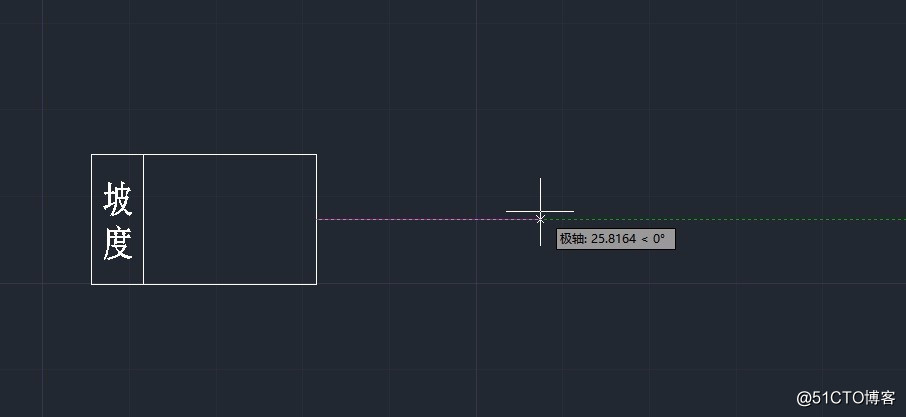标签:sys erro man add util model device ase pos
C++实现坡度编辑命令,指定基点的情况下提示用户拾取一个点。主要思路是:
图例如下:

示例如下:
程序入口点代码
```c++
//zhaoanan 坡度绘制
// - zndraw_thslope command (do not rename)
//自定义实体绘制坡度
static void zndraw_thslope(void)
{
AcDbDatabase m_pDb = acdbHostApplicationServices()->workingDatabase();
//添加块定义
acutPrintf(_T("\n坡度绘制")) ;
CUserSystem mysys = new CUserSystem();
mysys->m_pDb = m_pDb;
//声明左边插入点
ads_point pt_insert;
AcGePoint3d pt_3d_insert;
int iOldOsMode = 0 ;
BOOL bReturn = false ;
while (bReturn == false)
{
int iReturn = acedGetPoint(NULL,_T("\n 指定坡度的插入点:"),pt_insert) ;
//int iReturn = acedEntSel(_T("\n选择实体对象"), en, pt) ;
if(iReturn == RTNORM)
{
bReturn = true ;
pt_3d_insert =asPnt3d(pt_insert);
acutPrintf(_T("\n坡度插入点坐标:x坐标为:%f,y坐标为:%f"), pt_3d_insert.x, pt_3d_insert.y);
//实例化轨道坡度对象
CthRailSlope *cthRailSlope = new CthRailSlope();
//指定坡度位置为插入点坐标
cthRailSlope->setPosition(pt_3d_insert);
//添加坡度组件
CthComponent *lineCp = new CthComponent();
//thComponent c = new thComponent();
//根据插入点,画坡度上面的横线
lineCp->addLine(AcGePoint3d(-26, 7.5, 0), AcGePoint3d(0, 7.5, 0));
//根据插入点,画坡度下面的横线
lineCp->addLine(AcGePoint3d(-26, -7.5, 0), AcGePoint3d(0, -7.5, 0));
//以插入点横坐标X=-26为基准向上和向下画竖线
lineCp->addLine(AcGePoint3d(-26, 7.5, 0), AcGePoint3d(-26, -7.5, 0));
//添加坡度框体中间的文字
CthText *text = lineCp->addText(_T("坡"), AcGeVector3d(-23, 2.5, 0), 3);
//指定字体对齐方式
text->setAlign(AcDbMText::kMiddleCenter);
text = lineCp->addText(_T("度"), AcGeVector3d(-23, -2.5, 0), 3);
//指定字体对齐方式
text->setAlign(AcDbMText::kMiddleCenter);
//以插入点横坐标X=-20为基准向上和向下画竖线
lineCp->addLine(AcGePoint3d(-20, 7.5, 0), AcGePoint3d(-20, -7.5, 0));
//将新建的组件添加到坡度对象
cthRailSlope->appendComponent(lineCp);
lineCp = new CthComponent();
//type=1, 没查到代表什么
lineCp->setType(1);
//根据插入点,以插入点为基准向上和向下画竖线
lineCp->addLine(AcGePoint3d(pt_3d_insert.x, pt_3d_insert.y + 7.5, 0), AcGePoint3d(pt_3d_insert.x, pt_3d_insert.y - 7.5, 0));
//给新加的竖线添加文字
text = lineCp->addText(_T(""), AcGeVector3d(pt_3d_insert.x, pt_3d_insert.y, 0), 2.5);
text->setName(_T("里程"));
//指定字体旋转角度
text->setRotation(PI / 2);
//指定字体对齐方式
text->setAlign(AcDbMText::kBottomCenter);
//将新建的组件添加到坡度对象
cthRailSlope->appendComponent(lineCp);
//获取devices.xml中的图层信息,给新建坡度对象添加图层
DTDevice* device = CZnUtility::GetDevice(cthRailSlope);
//如果获取的devices.xml中的坡度相关图层信息不为空
if(device != nullptr && (!device->GetLayer().IsEmpty()))
{
//将图层信息添加到图层表中
if (addLayer(device))
{
//如果图层信息添加到图层表成功,那么将图层信息赋值给当前坡度图层
cthRailSlope->setLayer(device->GetLayer());
}
}
//将里程实体加入到块表记录中
//cthRailSlope->AddRailSlope("ZDK1+222.45", "ZDK2+123.11", "20", 20.00, "30", cthRailSlope->position().x + 20, cthRailSlope->position().x + 50, 1);
AcDbObjectId dimensionId = CDwgDatabaseUtil::PostToModelSpace(cthRailSlope, m_pDb);
}
else if (iReturn == RTERROR)
{
bReturn = false ;
}
else if (iReturn == RTCAN) {
bReturn = true ;
}}
//保存当前图层,设置要绘制的图层
AcDbObjectId ojbIdLayerOld = m_pDb->clayer() ;
m_pDb->setClayer(ojbIdLayerOld) ; //恢复当前图层
}
拖拽程序代码,要有坡度编辑的时候有参照线,指定基点的情况下提示用户拾取一个点,代码实现:
```c++
//刷新窗口 当即生效
int CGetInputUtil::GetPointReturnCode(const AcGePoint3d &basePoint, const TCHAR* prompt, AcGePoint3d &point)
{
//将基点转换为UCS坐标
AcGePoint3d ucsBasePoint = CConvertUtil::WcsToUcsPoint(basePoint);
int nReturn = acedGetPoint(asDblArray(ucsBasePoint), prompt, asDblArray(point));
if (nReturn == RTNORM)
{
//acedGetPoint得到UCS坐标,转换为WCS
point = CConvertUtil::UcsToWcsPoint(point);
}
return nReturn;
}
坡度编辑代码
```c++
//zhaoanan 坡度编辑
// - zndraw_thslope command (do not rename)
//自定义实体坡度编辑
static void zndraw_thslopeedit(void)
{
AcDbDatabase m_pDb = acdbHostApplicationServices()->workingDatabase();
//添加块定义
acutPrintf(_T("\n坡度编辑")) ;
CUserSystem mysys = new CUserSystem();
mysys->m_pDb = m_pDb;
//声明左边插入点
ads_name en ;
ads_point pt ;
BOOL bReturn = false ;
while (bReturn == false)
{
int iReturn = acedEntSel(_T("\n选择坡度实体对象"), en, pt) ;
if(iReturn == RTNORM)
{
bReturn = true ;
AcDbEntity * pEnt = NULL ;
CthRailSlope * pthEnt = NULL;
if(mysys->OpenAcDbEntity(en, pEnt, AcDb::kForRead))
{
acedUpdateDisplay();
//指定坡度端点
if(pEnt->isKindOf(CthRailSlope::desc()))
{
pthEnt = CthRailSlope::cast(pEnt) ;
pthEnt->upgradeOpen();
//获取里程值
CthComponent *pCpnt = pthEnt->getComponent(pthEnt->getComponentCount() - 1);
CthLine* line= (CthLine*)pCpnt->getElement(0);
AcGePoint3d pt_3d_base(line->startPoint().x, pthEnt->position().y, 0);
// 左里程
CString m_left_kmpost = "";
//进行非空判断,可能为空,没有添加过左公里标时为空
if (pCpnt != NULL) {
CthElement *pElm = pCpnt->getElement(_T("里程"));
if (pElm->type() == 32)
{
CthText* pText = (CthText*)pElm;
//更新里程值内容
m_left_kmpost = pText->textString();
}
}
//acutPrintf(_T("\n坡度基准点坐标:x坐标为:%f,y坐标为:%f"), pt_3d_base.x, pt_3d_base.y);
//画出虚拟参考线
//声明极轴追踪模式
int iOldPolarMode = 0;
//得到原极轴追踪模式
mysys->GetSysVar(_T("AUTOSNAP"), iOldPolarMode);
//设置极轴追踪模式,0为不极轴追踪,8为极轴追踪
mysys->SetSysVar(_T("AUTOSNAP"), 8) ;
CRailSlopeEditJig *pJig = new CRailSlopeEditJig();
pJig->DoIt(pt_3d_base);
//恢复原极轴追踪模式
mysys->SetSysVar(_T("AUTOSNAP"), iOldPolarMode) ;
int len = pJig->m_3dPoints.length();
//打开窗体
if (len>=2)
{
CAcModuleResourceOverride myResources ;
RailSlopeEditDlg dlg = new RailSlopeEditDlg();
//值的初始化
dlg.cthRailSlope = pthEnt;
dlg.m_left_kmpost = m_left_kmpost;
dlg.m_pt3dBasePoint = pthEnt->position();
dlg.m_pt3dStartPoint = pJig->m_pt3dStart;
dlg.m_pt3dEndPoint = pJig->m_pt3dEnd;
int nRet = dlg.DoModal();
if (nRet == IDOK)
{
acutPrintf(_T("\n坡度编辑完成")) ;
} else if (nRet == IDCANCEL) {
acutPrintf(_T("\n坡度编辑已取消")) ;
}
}
//获取名称
pthEnt->downgradeOpen();
}
else
{
AfxMessageBox(_T("选择的不是坡度实体!")) ;
bReturn = false ;
}
if(pEnt!=NULL)
{
pEnt->unhighlight() ;
pEnt->close();
}
acedUpdateDisplay();
}
//AcDbObjectId dimensionId = CDwgDatabaseUtil::PostToModelSpace(cthRailSlope, m_pDb);
}
else if (iReturn == RTERROR)
{
bReturn = false ;
}
else if (iReturn == RTCAN) {
bReturn = true ;
}}
//保存当前图层,设置要绘制的图层
AcDbObjectId ojbIdLayerOld = m_pDb->clayer() ;
m_pDb->setClayer(ojbIdLayerOld) ; //恢复当前图层
}
参考意见和网页地址:
ObjectArx-C++实现 坡度编辑命令-指定基点的情况下提示用户拾取另一个点
标签:sys erro man add util model device ase pos
原文地址:https://blog.51cto.com/zhaoanan/2542630